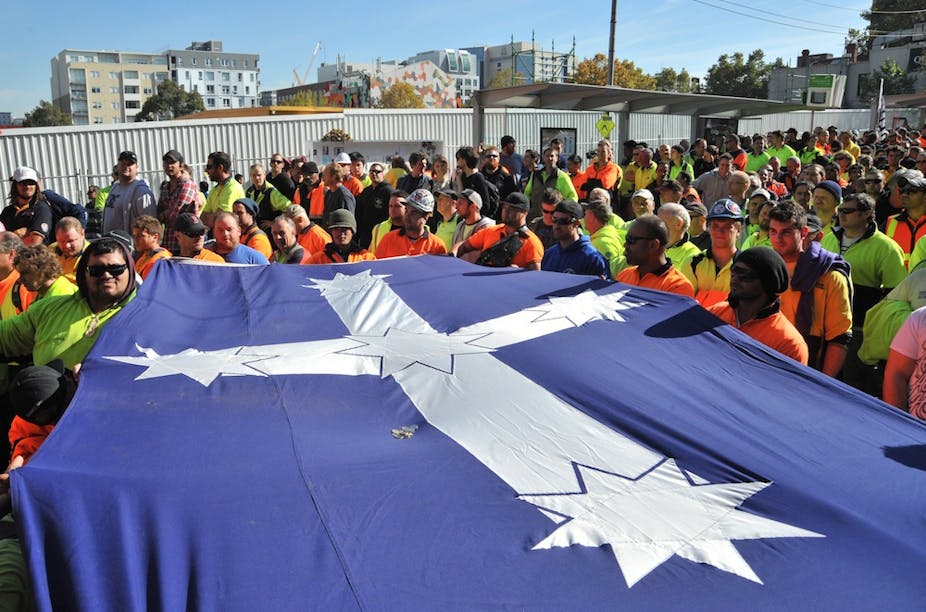In the wake of the ALP’s poor result in the recent Western Australia Senate election, The Conversation is publishing a series of articles looking at the party’s brand, organisation and future prospects.
In the last two years Labor has witnessed the worst electoral performances in its history. In 2012, Queensland Labor was reduced to a rump of seven seats in the state parliament, a lower representation than what it obtained in its first electoral showing in 1893.
In the recent Tasmanian state election, and in the Western Australian senate election, Labor’s primary vote was the lowest in 100 years. At the last federal election, the percentage of the electorate that voted for a Labor candidate (34%) was less than that secured in the 1932 election (37.7%) when the Scullin government lost power in the depths of the Great Depression.
As calls for party “reform” mount, a variety of Labor leaders argue that the good times will only return for the party if it ends “union control”. The problem with this argument is that Labor today is not a “union controlled” party. Rather, it is a faction-run party, unburdened by any ideals.
In exercising power, the factions use many levers - branch stacks, the union bloc vote and business financial donations that pay the dues of “phantom” members. The loss or diminishment of one lever will cause little inconvenience. If the union vote is lost, the factions will simply pull harder on other levers.
Once upon a time, Labor was certainly a union-dominated party, just as Australia was a union-dominated society. In 1948, when union density reached its peak, 64.9% of the workforce belonged to a union. At this time, two-thirds of the working population was found in manual, blue-collar jobs.
In this world, unions and their leaders were highly respected figures in working-class society. Labor’s association with unionism was its greatest boon. By 1970, however, things had changed. Technology had destroyed traditional jobs. Blue-collar workers had became a minority force.
In 1971, for the first time in decades, non-unionists became a majority of the workforce. Realising that Labor needed to win the support of the growing professional middle-class, Gough Whitlam pursued policies in education and social policy that emphasised individual advancement. In the state Labor branches, most notably Victoria and Queensland, “reform groups” dramatically increased the power of the (increasingly middle-class dominated) local branch membership.
Affiliated unionists lost the automatic right to vote in Labor plebescites. Increasingly, Labor pursued policies such as privitisation, tariff reductions and enterprise bargaining that appealed to business and the middle-class but did the shrinking union movement great harm.
As union power declined, both within Labor and the wider society, a reverse take-over occurred. Unions hired young, university-educated Labor activists as industrial officers. Over time, these people progressed up the union hierarchy, often assuming controlling influence.
Even where unions remained under the control of people who had progressed up from the shop floor, union leaders increasingly became part of a new Labor elite, marrying parliamentary members and accepting positions on corporate boards.
At the same time, however, unions and union members became less influential in the political process. As my recent study of Queensland Labor, published in the November 2013 edition of Labour History shows, by 1998 unions were contributing only 14.1% of the branch’s income. Instead, business donations and investment income bankrolled the party.
Business donations also swelled factional coffers; donations that were used to pay the dues of non-existent members. As the 2001 Queensland investigation into electoral fraud, the Shepherdson inquiry revealed, when party plebescites were held the ballots of these “phantom” members were collected from “safe houses” and cast by trusted operatives.
By the late 1990s the Labor Party had morphed from a union-controlled party into a faction-controlled party. Today, the power base of these factions is everywhere and nowhere. While primarily drawn from the professional middle-class, the factional warlords are a nebulous group whose composition is self-selected. To the extent that this group has ideals, they are increasingly removed from the concerns of society’s “battlers”.
Issues such as global warming, rather than rising electricity prices, stir discussion. Certainly, factional control of the unions is still a key factor in the exercise of power within Labor. But it is only one factor, and by no means a decisive one.
If Labor were today to end its union ties it would, for Labor, change very little. If unions were no longer affiliated, the factions could recruit large numbers of union members, be they paid officers or rank-and-file activists, directly into the party. They could also use money obtained from business benefactors to pay the dues of the non-existent or disinterested member.
Even if, by some miracle, “democratic” membership control was obtained, Labor’s problems would be far from over. What policies would Labor stand for? If it advocated pro-environment policies, as its inner-city membership would no doubt advocate, then pro-development regional and rural voters and members would be alienated.
If it became a more forceful pro-environment party, what differentiates it from the Greens? Alternatively, if it became a more forceful pro-development party, what differentiates it from the Nationals?
Given such conundrums, the only likely beneficiaries of a union-Labor split are trade unionists. Currently, they gain little and - as the Williamson and Thompson sagas showed - often lose much from the current arrangements.

